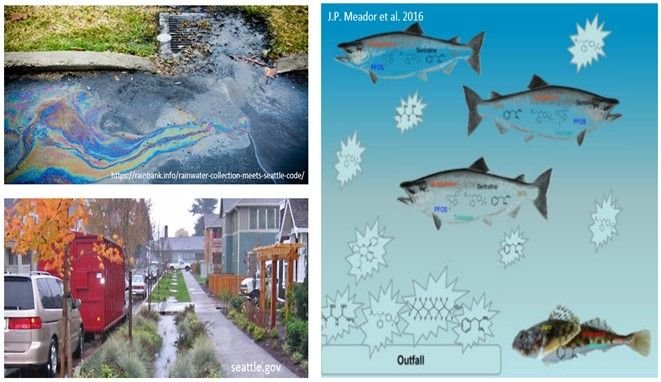Visualizing Ecosystem Land Management Assessments (VELMA) Model
[NOTICE] VELMA is currently undergoing an External Peer Review. In the interim, the latest version 2.1 is now available. Following the review, EPA will release version 2.2.
Description
VELMA (Visualizing Ecosystem Land Management Assessments) is a tool designed to model effective decisions for a wide array of environmental issues. It is a spatially explicit ecohydrological watershed model that planners can use to visualize the effects of their decisions.
VELMA can be used to help improve the water quality of streams, rivers, and estuaries by making better use of both natural and engineered green infrastructure (GI) to control loadings from point and nonpoint sources of pollution. It is designed to help users assess green infrastructure options for controlling the fate and transport of water, nutrients, and toxics across multiple spatial and temporal scales for different ecoregions and present and future climates. VELMA also addresses GI maintenance and longevity to predict how once-effective riparian buffers can fail, depending upon contaminant loads, soil properties, changes in climate and other factors. VELMA was designed for use by communities, land managers, policy makers, and scientists and engineers.
Application
- Compare the effects of GI and climate scenarios on water quality and associated co-benefits and trade-offs for other ecosystem services.
- GI applications for essentially any region and set of environmental conditions.
- Quantify co-benefits of GI practices, specifically to quantify tradeoffs among important ecosystem services – that is, the capacity of an ecosystem to provide clean water, flood control, food and fiber, climate (greenhouse gas) regulation, fish and wildlife habitat, among others.
- Use as a common framework to compare GI strategies across ecoregions, habitat types and biophysical conditions.
Note: View VELMA 2.1 disclaimer following download of the model.

Downloads
| File Name | Description |
|---|---|
| VELMA User Manual and Model | Latest download of the VELMA user manual and Model (version 2.1). Contents include a zip file of the VELMA executable software, supporting tools, user manual, and example green infrastructure applications. |
| VELMA User Manual (PDF) | Learn more about how to download and use VELMA in the complete guide for operating VELMA v2.x. |
| VELMA LPDEM User Manual (PDF) | Learn more about determining outlet and watershed delineation using the VELMA v2.0 simulator. |
| VELMA Case Study | 2021 Ecosystem Services Coordinated Case Study for the Pacific Northwest |
| VELMA Quick Example | Example simulation configuration and associated input maps and driver data |
| VELMA Fact Sheet | Factsheet on using VELMA to identify green infrastructure for enhancing water quality and ecosystem service co-benefits. |
Publications
The following links exit the EPA website:
- High-resolution spatial modeling of daily weather elements for a catchment in the Oregon Cascade Mountains, United States. Daly et al. Journal of Applied Meteorology and Climatology, 46(10), pp.1565-1586. October 2007.
- In Oregon, the EPA calculates nature’s worth now and in the future. Bolte et al. Solutions Journal (6) 2:35-41. Nov-Dec 2011.
- Characterizing mercury concentrations and fluxes in a Coastal Plain watershed: insights from dynamic modeling and data. Golden et al. J. Geophys. Res. Biogeosci. 117, 17. January 2012.
- An algorithm for treating flat areas and depressions in digital elevation models using linear interpolation. Pan et al. Water Resources Research, 48(6). February 2012.
- Practical Strategies for Integrating Final Ecosystem Goods and Services into Community Decision-Making. Yee et al. US Environmental Protection Agency, Office of Research and Development. August 2017.
- How Visualizing Ecosystem Land Management Assessments (VELMA) modeling quantifies co-benefits and tradeoffs in Community Forest management. McKane et al., keynote presentation (link), Northwest Community Forest Forum. Astoria, Oregon. May 2018.
- Cumulative effects of low impact development on watershed hydrology in a mixed land-cover system. Hoghooghi et al. Water, 10(8), p.991. July 2018.
- Embedding co-production and addressing uncertainty in watershed modeling decision-support tools: Successes and challenges. Barnhart et al. Environmental Modelling & Software. Elsevier Science, New York, NY, 109:368-379. August 2018.
- Improved soil temperature modeling using spatially explicit solar energy drivers. Halama et al. Water, 10(10), p.1398. October 2018.
- Penumbra: A spatially distributed, mechanistic model for simulating ground-level incident solar energy across heterogeneous landscapes. Halama et al. PloS one, 13(12), p.e0206439. December 2018.
- Modeling the hydrologic effects of watershed-scale green roof implementation in the Pacific Northwest, United States. Barnhart et al. Journal of Environmental Management, 277, p.111418. October 2020.
- An integrated multi-model decision support framework for evaluating ecosystem-based management options for coupled human-natural systems. McKane et al. Ecosystem-based management, ecosystem services and aquatic biodiversity: Theory, tools and applications, pp.255-274. August 2020.
- Comparative Assessment of the Impacts of Prescribed Fire Versus Wildfire (CAIF): A Case Study in the Western U.S. U.S. Environmental Protection Agency, Washington, DC, EPA/600/R-21/197, September 2021.
- Catchment hydrological responses to forest harvest amount and spatial pattern. Abdelnour et al. Water Resources Research. September 2011.
- Characterizing mercury concentrations and fluxes in a Coastal Plain watershed: Insights from dynamic modeling and data. Golden et al. Journal of Geophysical Research. January 2012.
- An algorithm for treating flats areas and depression in digital elevation models using linear interpolation. Pan et al. Water Resources Research. February 2012.
- Identification of optimal soil hydraulic functions and parameters for predicting soil moisture. Pan et al. Hydrological Sciences Journal. April 2012.
- Effects of harvest on carbon and nitrogen dynamics in a Pacific Northwest forest catchment. Abdelnour et al. Water Resources Research. March 2013.
- Hydrological connectivity between geographically isolated wetlands and surface water systems: A review of select modeling methods. Golden et al. Environmental Modelling and Software. December 2013.
- Mercury and methylmercury stream concentrations in a Coastal Plain watershed: A multi-scale simulation analysis. Knightes et al. Environmental Pollution. April 2014.
Resources
- Green Infrastructure: provides information, research, tools, case studies, and publications.
- Green Infrastructure Research: provides information on current research activities and outputs.
- Ecosystems Research: provides information on current research activities and outputs.
